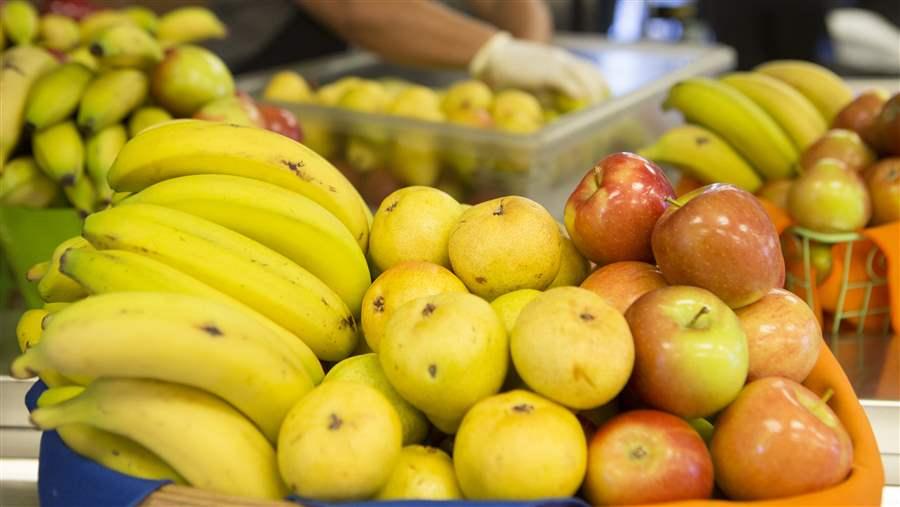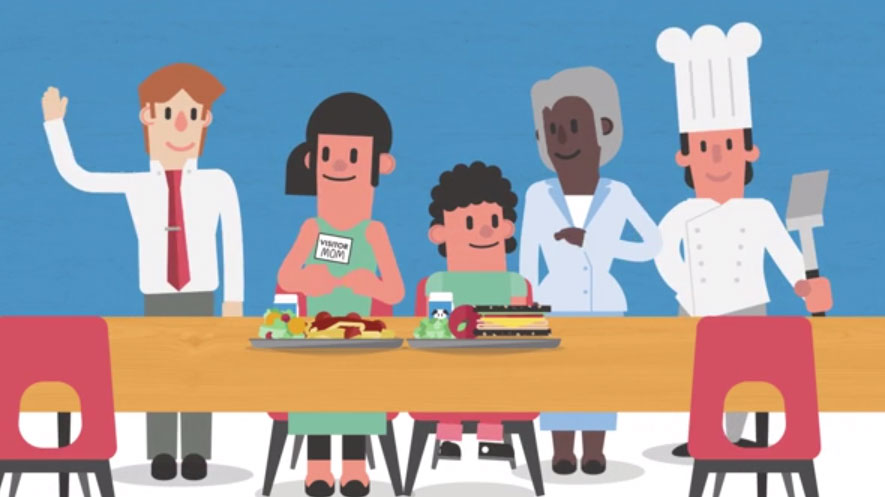Healthy School Snacks Promote Student Nutrition
More kids chose school lunches after strong snack policies took effect, study finds
 The Pew Charitable Trusts
The Pew Charitable TrustsSchools that offer healthy snack options, such as apples, have seen a decrease in the amount of fat, sugar, and calories that students consume.
Most schools sell snacks and beverages to students in cafeteria a la carte lines, vending machines, or stores, and these foods can have important consequences for kids’ health. The consumption of 110 to 165 calories above recommended daily amounts—roughly the difference between an apple and a bag of chips—may be responsible for rising childhood obesity rates.
Thanks to Congress’ 2010 child nutrition law, the U.S. Department of Agriculture strengthened standards for snacks and drinks sold at school, which had not been revised since 1979. These preliminary guidelines, known as the Smart Snacks in School rule, complement the updated national standards for breakfasts and lunches that Congress also required. Together, these policies ensure that no matter where on campus children get food or drinks, their choices will provide the nutrition they need to grow up healthy.
School Snacks by the Numbers
Snacks bought at school can play a big role in kids’ diets and well-being, but until recently, many students did not have healthy food and beverage options available a la carte or in vending machines. These facts underscore the need for and support behind the USDA’s Smart Snacks in School rule.
- 4 in 10: Share of students who buy and eat one or more snacks at school.
- 89%: Proportion of high school students who could buy sugar-sweetened beverages at school before USDA’s rule took effect.
- 200: Average number of calories that school-purchased snacks add to a student’s daily intake.
- 49: States where less than half of secondary schools sold fruits and vegetables for snacks in 2010.
- 16%: Average share of school meal program revenue from sales of snack foods and beverages.
- More than 200,000: Number of supportive public comments the USDA received after proposing the rule.
- 72%: Percentage of voters with children in public schools who favor requiring schools to meet snack nutrition standards.
A new study of Massachusetts schools shows that the state’s guidelines, which are similar to the USDA’s, have improved kids’ healthy snack options and spurred a 15 percent increase in lunch participation among students who qualify for reduced-price meals. The researchers also found that although snack sales declined as less nutritious items were removed, school meal programs’ overall revenue was essentially unchanged two years after the snack rule took effect.
These findings echo those of a national health impact assessment commissioned by the Kids’ Safe and Healthful Foods Project, which showed that, on average, school districts’ food service revenue and meal program participation rates stayed level or increased in states that updated their snack food and beverage nutrition policies. For example, the Cincinnati school district saw a dramatic jump in meals served after snack food and beverage standards took effect. Participation grew 64 percent in high schools and 90 percent in elementary schools, turning a budget deficit into a $4.5 million surplus.
Later this year, the USDA is expected to issue a final Smart Snacks in School rule with minor adjustments to the interim standards now in place. The evidence from Massachusetts, Cincinnati, and elsewhere makes a compelling case that strong snack nutrition standards are working for kids and schools alike. All students deserve healthy food and drink options while at school, and with the support of parents and policymakers, every district is capable of providing these choices.
How Have Children’s Options Changed Under the Smart Snacks in School Rule?
Calorie counts of available food and beverage options

Source: The Pew Charitable Trusts, "Sizing Up Snack Foods and Drinks," last modified Feb. 20, 2015, http://www.pewtrusts.org/en/multimedia/data-visualizations/2015/sizing-up-snack-foods-and-drinks.
Spotlight on Mental Health


This video is hosted by YouTube. In order to view it, you must consent to the use of “Marketing Cookies” by updating your preferences in the Cookie Settings link below. View on YouTube
This video is hosted by YouTube. In order to view it, you must consent to the use of “Marketing Cookies” by updating your preferences in the Cookie Settings link below. View on YouTube
Latest from Health
MORE FROM PEW
Explore Pew’s new and improved
Fiscal 50 interactive
Your state's stats are more accessible than ever with our new and improved Fiscal 50 interactive:
- Maps, trends, and customizable charts
- 50-state rankings
- Analysis of what it all means
- Shareable graphics and downloadable data
- Proven fiscal policy strategies
Welcome to the new Fiscal 50
Key changes include:
- State pages that help you keep track of trends in your home state and provide national and regional context.
- Interactive indicator pages with highly customizable and shareable data visualizations.
- A Budget Threads feature that offers Pew’s read on the latest state fiscal news.










